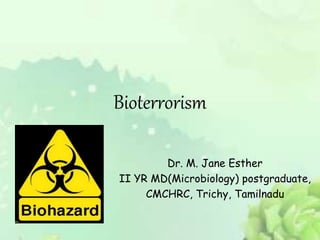
Bioterrorism
- 1. Bioterrorism Dr. M. Jane Esther II YR MD(Microbiology) postgraduate, CMCHRC, Trichy, Tamilnadu
- 2. Definition • Terrorism : “The unlawful use of force and violence against persons or property to intimidate or coerce a government, the civilian population, or any segment” • Bioterrorism: bioterrorism attack is the deliberate release of viruses, bacteria, toxins or other harmful agents used to cause illness or death in people, animals, or plants.
- 3. Bioterrorism
- 4. Why are they used? • Can be easily disseminated, and can cause widespread fear and panic beyond the actual physical damage • Bioterrorism is an attractive weapon because biological agents are relatively easy and inexpensive to obtain. • The use of agents that do not cause harm to humans but disrupt the economy have been discussed. Eg. Foot and mouth disease virus • Some bioterrorism agents, like the smallpox virus, can be spread from person to person and some, like anthrax, cannot.
- 5. Key Features of Biologic Agents Used as Bioweapons • High morbidity and mortality • Potential for person-to-person spread • Low infective dose and highly infectious by aerosol • Lack of rapid diagnostic capability • Lack of effective vaccine • Potential to cause anxiety • Environmental stability • Potential to be “weaponized”
- 6. Earliest attempts at biological warfare • 400 BC – Scythian archers – arrows dipped in blood • 300 BC – Greek & Romans – animal cadavers – contaminate water supplies • 190 BC- Hannibal hurled snakes onto empty ships of King Eumenes
- 7. • 1346 – Mongols catapulted bodies of plague victims over city walls • 1718 – Russians tried the same tactic against Sweden • 1763 – British gave small pox inoculated blankets to Indians
- 8. 20th century • By the time World war 1 began, attempts to use anthrax were directed at animal populations. • Dilger from Germany -infected horses with glanders while they were waiting to be shipped to Britain
- 9. • In 1972 police in Chicago arrested two college students, Allen Schwander and Stephen Pera, who had planned to poison the city's water supply with typhoid bacteria.
- 10. 21st century • In Oregon , followers of the Shree Rajneesh attempted to control a local election by incapacitating the local population – Salmonella typhimurium. • Letters laced with infectious anthrax were concurrently delivered to news media offices and the U.S Congress. The letters killed thousands of people
- 12. CLASSIFICATION • Category A, B and C – CDC Category A •Easily disseminated •High mortality rates •Major public health impact •Public panic and social disruption Category B •Moderately easy to disseminate •Low mortality rates Category C •Emerging pathogens •Could be engineered for mass dissemination in the future
- 13. Category A agents Bacteria Viruses •Anthrax (Bacillus anthracis) •Botulism (Clostridium botulinum toxin) •Plague (Yersinia pestis) •Smallpox (Variola major) •Tularemia (Francisella tularensis) •Viral hemorrhagic fevers: •Arenaviruses: Lassa, New World (Machupo, Junin, Guanarito, and Sabia) •Bunyaviridae: Crimean Congo, Rift Valley •Filoviridae: Ebola, Marburg • •Flaviviridae: Yellow fever; Omsk fever; Kyasanur Forest
- 14. Tularemia • Rabbit fever • Inhalation • Respiratory infection • Life threatening pneumonia
- 15. Anthrax • Bacillus anthracis • Direct skin contact – cutaneous • Inhalation – pulmonary • Ingestion of carcasses of infected animals – intestinal anthrax
- 16. Small pox • Highly contagious • Inhalation • High mortality • Eradicated
- 17. Botulinum toxin • Clostridium botulinum • Respiratory failure and paralysis • High mortality
- 18. Bubonic plague • Yersinia pestis • Rodents • Flea bite • Bubonic • Pneumonic • Septicaemic
- 19. Category B agents • Moderately easy to disseminate • Result in moderate morbidity rates and low mortality rates • Require specifically enhanced diagnostic capacity
- 20. Category B agents • Brucellosis (Brucella spp.) • Clostridium perfringens • Glanders (Burkholderia mallei) • Melioidosis (B. pseudomallei) • Psittacosis (Chlamydia psittaci) • Q fever (Coxiella burnetii) • Ricin toxin from Ricinus communis (castor beans) • Staphylococcal enterotoxin B • Typhus fever Food safety threats: Salmonella sp. Escherichia coli Shigella sp. Water safety threats Vibrio cholerae Cryptosporidium parvum
- 21. Category C agents • Include emerging pathogens • Could be engineered for mass dissemination in the future because of availability, ease of production, ease of dissemination • The recent emergence of novel viruses leading to outbreaks of severe acute respiratory syndrome (SARS), Nipah, hantavirus are examples
- 22. T2 - mycotoxins • Tricothecene mycotoxins -are nonvolatile compounds produced bi filamentous fungi primarily of the genera Fusarium, Myrotecium, Trichoderma, and Stachybotrys. • Inhalation, Dermal, and Oral. • Involve eyes, skin, respiratory and gastrointestinal tracts. • Death rate : 10 to 20 %
- 23. Is it really bioterrorism? • Outbreak of a rare disease • Seasonal disease at a wrong time • Unusual age distribution • Unusual clinical symptoms • Unsual epidemiologic features • Outbreak in a region / geographic location where it is not normally seen
- 24. How to be prepared for a BT attack? • Familiarize medical staffs with agents of BT Incorporate into disaster planning – • Decontamination & infection control • Communication with key agencies- Laboratory, Respective national health authorities • Contacts to obtain stockpiled supplies – Antibiotics, Immune sera, Vaccines, etc • Security preparations
- 26. Preparedness • Laboratories are working on advanced detection systems to provide early warning, identify contaminated areas and populations at risk, and to facilitate prompt treatment.
- 27. References • Bioterrorism – emergency preparedness and response – CDC • Bioterrorism – Dr.T.V.Rao ppt • Bioterrorism – Infectious diseases- National academics of science